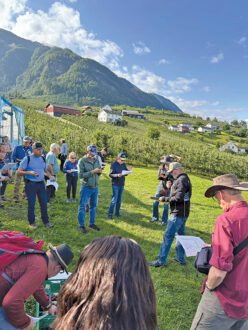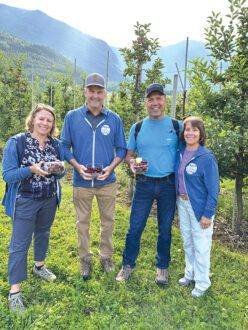

Jan 21, 2024Norway’s unique landscape, laws drive tree fruit plans
Renowned for its breathtaking natural beauty, with fjords, mountains, glaciers and pristine lakes, Norway’s landscapes are often described as some of the most picturesque in the world.
At first glance, however, a fruit farmer probably wouldn’t consider planting an orchard only 500 miles south of that Arctic Circle on steep slopes.


Growers from across North America viewed the Scandinavian country’s fruit industry firsthand, thanks to this summer’s July 27-Aug. 5 International Fruit Tree Association (IFTA) tour.
Norway fruit cultivation can be traced to ancient times when the Vikings and early Christian monks planted apple trees in the 13th Century. Apples were one of the first fruits to be cultivated in the region. Today, the country sports a vibrant fruit growing industry due to many factors:
Cool climate
Norway’s cool climate is advantageous for apples, pears, plums and berries. The slow ripening process in the cool climate with long summer daylight hours results in fruit with excellent flavor and sweetness. In Balestrand, one of the larger growing areas, the warm season lasts from June to early September, with an average daily high temperature around 60° F. The coldest months of winter average a high of 34° F and a low of 26° F.
Long daylight hours
During the summer months, Norway experiences long daylight hours, especially in the northern regions. The extended daylight makes up for the cooler temperatures in the summer. Some of the major growing areas see 10 hours of sunlight in March and April; 15-20 hours May-July; 10-13 hours August-October; then 7-8 hours of daylight in winter the months of November-February. The winter is mostly overcast.
Favorable microclimates


Norway fruit growers take full advantage of the microclimates created by the country’s well-known fjords: the deep and narrow inlets of the sea surrounded by steep cliffs. The fjord seldom freezes with winter temperatures averaging in the low 30s.
Fresh water resources
The fjords and rainfall during the growing season provide abundant fresh water resources. The one downside is for cherry growers who must use high tunnels to avoid cracking.
Short transport distances
Shipping costs are low as the majority of the fruit is consumed by the country’s 5.4 million inhabitants, with one million of those living in the capital of Oslo.
Government support of agriculture
Growers in Norway are paid subsidies based on how much fruit they produce. One grower said he receives about $5,800 per acre on a good yield of apples. Sales of Norwegian farm properties above 3.5 hectares of agricultural land require governmental approval if the sale goes outside the family. Because of this, most fruit farms are very small and family-owned. More than 80% of fruit growers are part-time.
New ground
Finding a fresh plot of land to grow fruit on is rare. Clearing land requires a high investment and a slew of government regulations. Fruit can only be grown up to about 300 meters above sea level and the ground is intensely rocky. The slopes are so steep in some areas that growers hire helicopters to bring in the supplies to establish an orchard.
Hard cider
The Norwegian government keeps tight reins on alcohol production and distribution. Production of cider thrived between 1890 and 1920. However, in 1920, the Vinmonopolet, or The Wine Monopoly, was founded. This government monopoly, on the sale of beverages with an alcohol content above 4.75%, stalled the production of cider.
In 2016 a new law was passed that allows growers to sell cider containing up to 22% alcohol direct to the consumer. This legal change has led to a vibrant hard cider industry of more than 60 producers. It has also spawned a new tourism industry called a cider safari where people stay at historic hotels and visit cider operations.
The event was organized by IFTA’s education director Greg Lang of Michigan State University and tour director Molly Crist of Onward travel.
*This is the first of several articles, which will highlight the International Fruit Tree Association’s 2023 Fruit in the Fjordlands Summer tour.
— Matt McCallum, Publisher
Top photo: The 39 participants of the IFTA Fruit in the Fjordlands summer tour visit the Jostedalsbreen glacier, which is the largest ice cap in mainland Europe.














